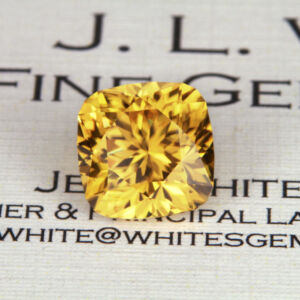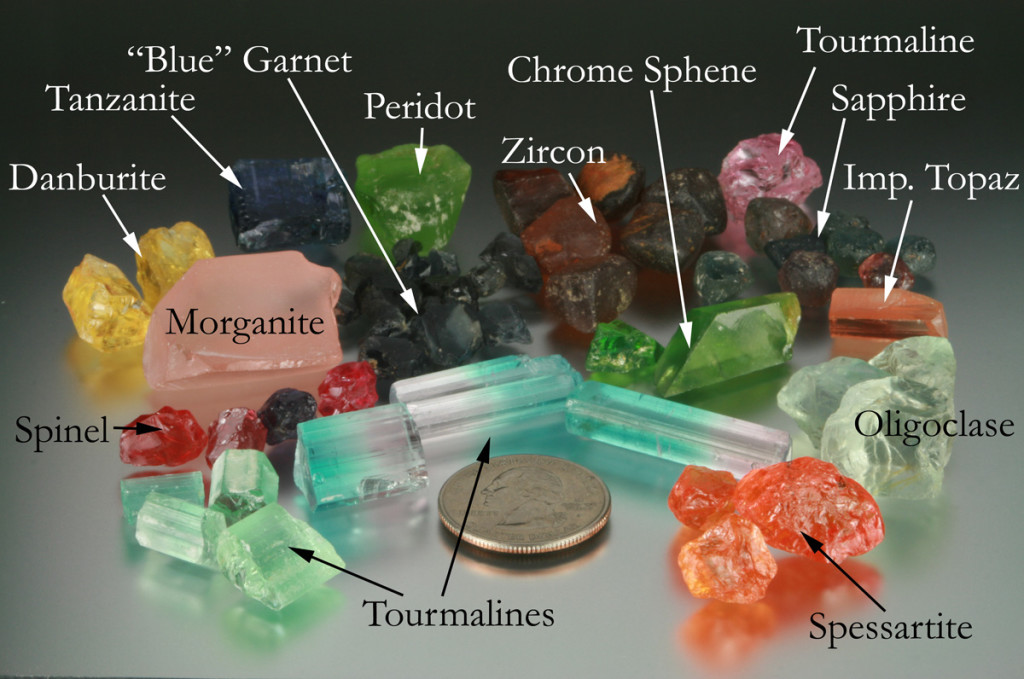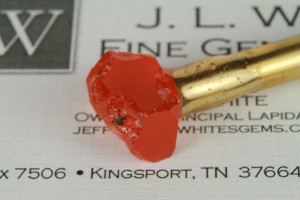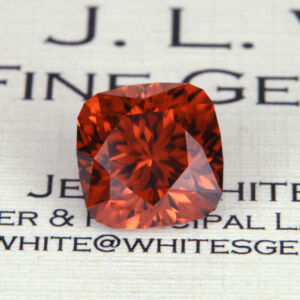What would you think if you saw this nondescript lump of brown on the side of the road? Would you even bother to pick up this unassuming little pebble?
What if I told you that the water-worn stone in that first photo would turn into this fiery yellow zircon?
This is the story of how humble little rocks such as the little brown pebble are transformed into magnificent finished gemstones.
When gems emerge from the ground, they can be strikingly-beautiful in their natural form. Mother Nature’s art can be hard to compete with. However, gem crystals have endured the rigors of thousands of years under tremendous geological forces so that once mined, they usually resemble shards of glass, river rocks, or other not-so-enticing forms. As such, gems in this stage are known as “rough” in the trade vernacular.
Our little pebble of zircon rough came from Tanzania. The smooth surface was caused by thousands of years spent tumbling about in a watery environment, much like a modern-day rock tumbler. This alluvial pebble was a dark coffee brown, and while possessing good clarity, most would agree it isn’t much to look at. Depending on the type of gem and the source, rough gemstones can take on many different forms. You can find our zircon in the photo below, along with various other gems from around the world:
After a piece of “rough” is assessed for any issues with internal inclusions, it is oriented for cutting, usually to obtain the highest yield possible. With some gem types, there are other considerations that must be given to orientation as well, such as color (since some gems display different colors in different directions), color zoning, and presence of cleavage planes (or directions in which a gem will easily split or “cleave”). Often, the stone will need to go through what is known as “preforming,” where initial grinding by hand is used to shape it and definitively determine the final orientation.

Once that work is completed, the rough is attached to a small stick that will be used to hold it in place during cutting. These sticks are called “dops,” and they can be made of anything from wood to brass or other metals. In the US, most dops are made of brass. Once “dopped,” the stone is ready for cutting.
“Gem cutting” is actually a grinding process. A flat disk, covered in tiny diamond particles, is spun at a high rate of speed and is used to grind away the excess gem material to produce a facet. Those disks, called “laps,” are available in a wide range of grit sizes, from very coarse to very fine.
While there is tremendous variety in the type and complexity of machines used to do the cutting, they all have a few things in common:
- something used to hold the dopped stone in place while cutting the desired facets,
- use of a spinning lap covered in diamonds (which actually does the grinding), and
- use of similar disks covered in a number of different substances to facilitate polishing.
It is a very hands-on process. The “machine” is nothing more than a spinning lap and a mechanism to hold the stone in the desired orientation. The cutting itself is all in the hands of the lapidary. In some cases, the dopped stone is even hand-held during the process!
After both “halves” of the gem are cut and polished, that is the end of the process for many gems. However, in some cases, a little extra help is needed to bring out the absolute best in a gemstone. Here is our little zircon immediately after cutting:
Not too bad, eh? However, orangy-brown color isn’t at the top of most folks’ “favorite colors” list. By heating the gemstone, an amazing transformation takes place at the atomic level. In the case of our zircon, the final outcome was the blazing yellow gem at the start of this article. Many other gem types on the market are typically heated to improve their color: sapphires, rubies, tanzanite, aquamarine and other beryls, tourmaline, and topaz, among others.
While by no means an exhaustive explanation of how a faceted gem is produced, hopefully this has been an interesting and entertaining look at the journey a gem takes from rough rock to finished stone.
Jeff White is an internationally-recognized gem cutter with almost two decades of experience. His work has been featured in leading industry publications such as Jewelry Business Magazine, Lapidary Journal Jewelry Artist, and Prism (the magazine of the American Gem Trade Association), as well as gem buying guides. Jeff is a Grand Master of the United States Faceters Guild and has won or placed in various national and international gem cutting competitions. Most-recently, he took first-place in the Faceting Division of the 2011 AGTA Cutting Edge Awards, which is considered by many to be one of North America’s highest honors in gem cutting. Jeff is the owner of JL White Fine Gemstones. (www.whitesgems.com, www.facebook.com/whitesgems)
